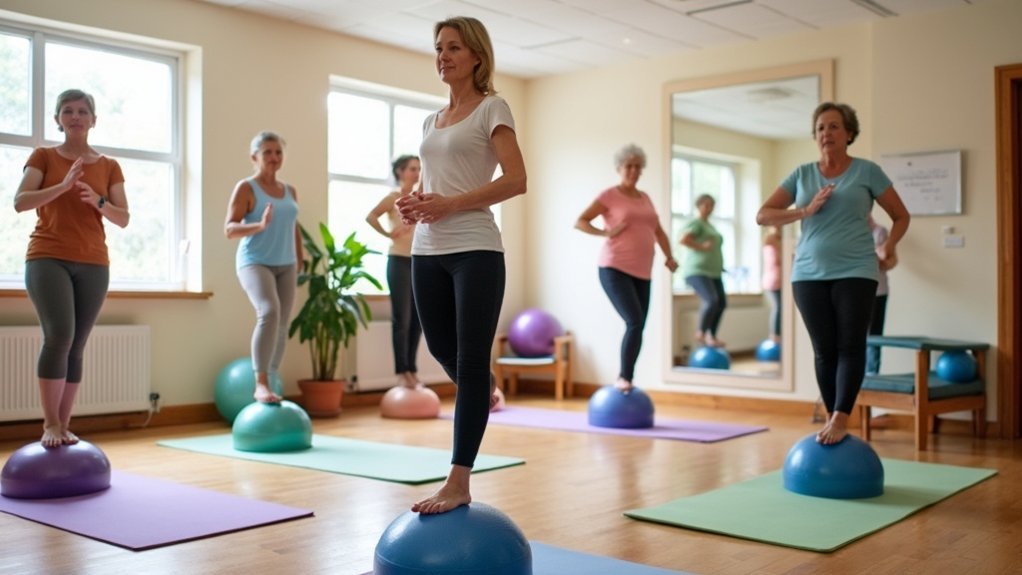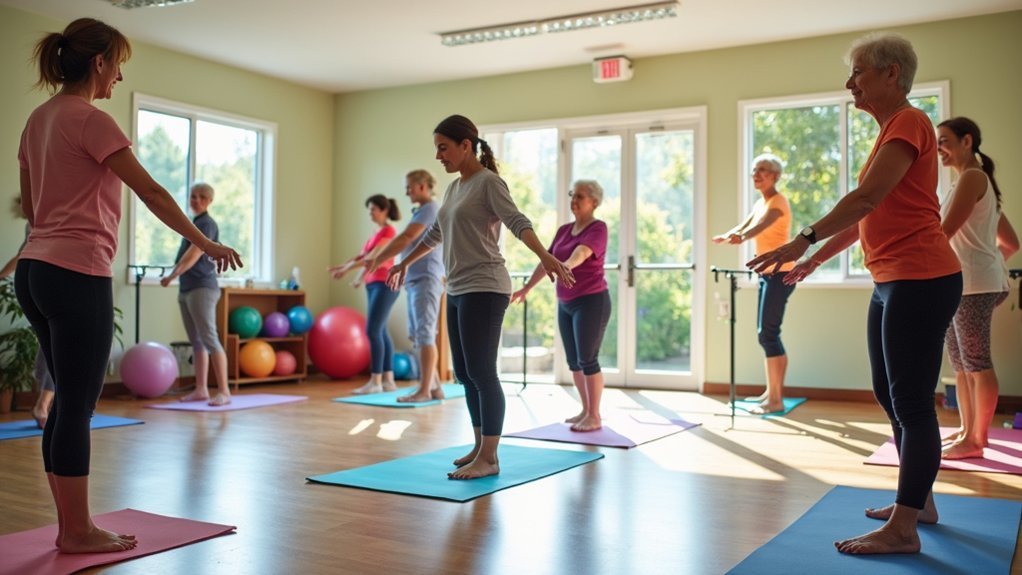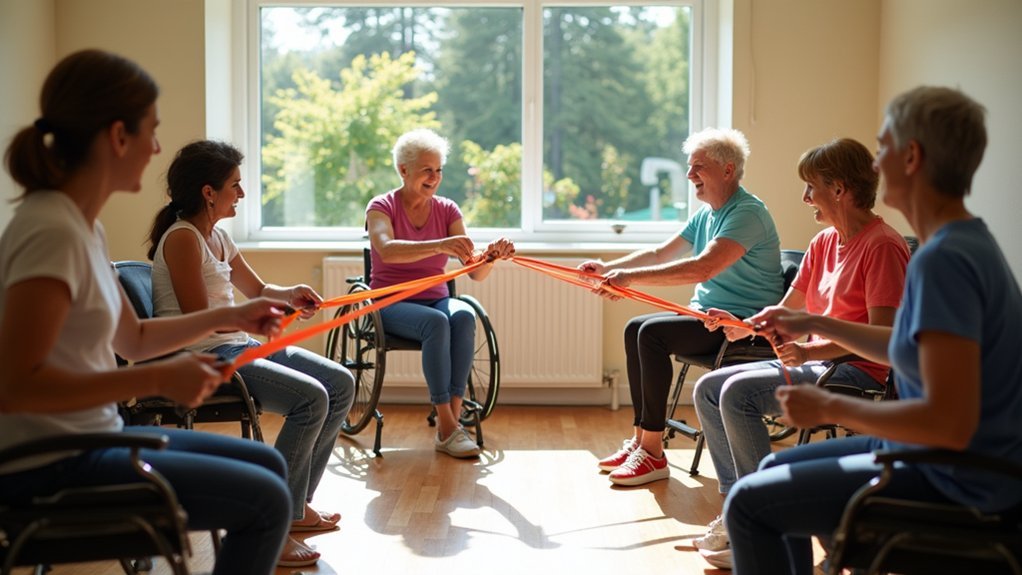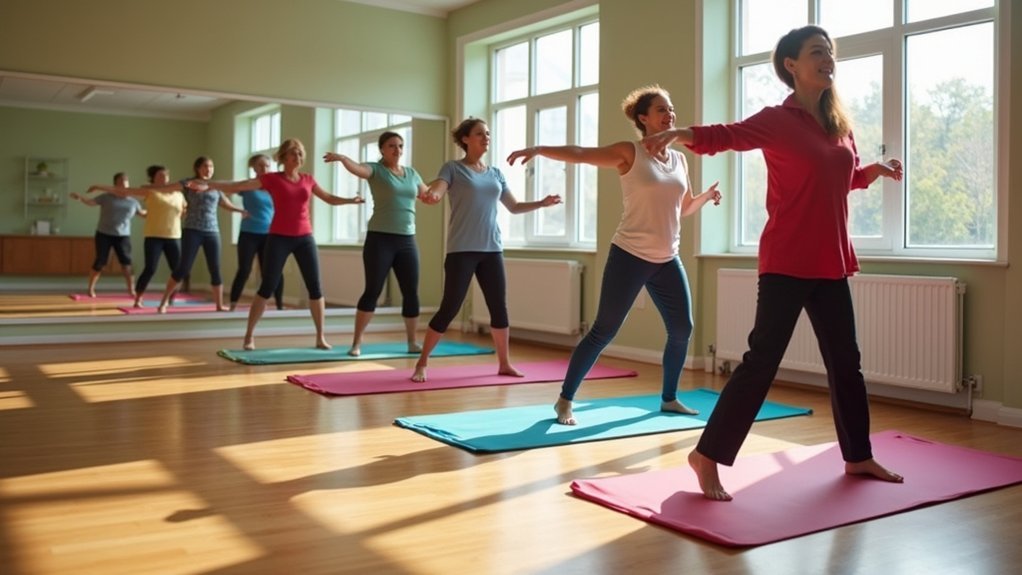Coordination exercises are essential for stroke recovery, helping your brain form new neural pathways. Start with simple seated activities like arm raises and leg extensions, then progress to standing balance exercises when ready. Incorporate daily tasks like dressing and cooking into your rehabilitation routine, as these stimulate both cognitive and motor functions. Using adaptive equipment such as therapy putty or resistance bands can greatly enhance your progress. The following exercises offer everyone effective rehabilitation options regardless of mobility level.
Understanding the Importance of Coordination in Stroke Recovery

When the brain experiences a stroke, coordination often becomes one of the most challenging functions to recover, particularly if the cerebellum or motor cortices have sustained damage.
Your ability to perform daily activities depends heavily on regaining these motor skills, especially in your affected arm and other limbs.
Regaining motor control in affected limbs is crucial for restoring independence in everyday tasks.
Coordination exercises aren’t just beneficial—they’re essential for stimulating neuroplasticity, the brain’s ability to form new neural connections.
During stroke recovery, high-repetition movements help your brain relearn control patterns.
Physical therapy programs that focus on coordinated movements can greatly improve both fine and gross motor skills while reducing fall risks.
Simple Seated Exercises to Rebuild Coordination Skills
Rebuilding coordination after a stroke starts with exercises you can perform while safely seated. These effective exercises allow you to focus on controlled movements without worrying about balance, making them ideal for stroke survivors working toward functional independence.
| Exercise | Benefit |
|---|---|
| Arm Raises | Improves shoulder stability and gross motor skills |
| Leg Extensions | Strengthens lower limbs and enhances mobility |
| Seated Marches | Develops hip flexor strength and leg coordination |
| Reaching & Grasping | Promotes bilateral movement and brain reactivation |
| Hand-to-Face Movements | Refines fine motor skills for daily activities |
Your physical therapist may recommend these seated exercises as they effectively target coordination skills through regular practice. As you master these movements, you’ll develop the foundation needed for more complex activities and greater independence in daily life.
Standing Balance Activities for Progressive Rehabilitation

Once stroke survivors have mastered seated exercises, standing balance activities become the next essential phase in rehabilitation. These exercises improve stability and reduce fall risks by enhancing proprioception and coordination skills that were compromised by neurological damage.
Start with simple activities like single-leg stands, gradually progressing to tandem walking. Utilize assistive devices such as walkers or canes for added support while you build confidence.
As you improve, incorporate dynamic movements—reaching or turning while maintaining balance—to regain functional mobility for everyday tasks.
Dedicate 15-30 minutes daily to these standing balance activities. This consistent practice stimulates neuroplasticity, strengthening connections between your brain and muscles.
Adaptive Equipment That Enhances Coordination Training
You’ll find remarkable progress using simple, affordable tools like weighted vests and therapy putty that can transform your home into an effective rehabilitation space.
These everyday items work alongside balance boards and stability balls to rebuild your coordination while strengthening core muscles essential for movement control.
For more extensive training, you might consider high-tech options such as motion-sensing games and specialized gait trainers that provide structured support while making your recovery journey more engaging and measurable.
Affordable Home-Based Tools
Five affordable tools can transform your home into an effective stroke rehabilitation center without breaking the bank.
Resistance bands provide variable resistance for coordination exercises targeting both upper and lower body muscles.
Stability balls improve core stability and balance when used for seated exercises, making them ideal for stroke patients working on coordination recovery.
Foam rollers enhance proprioception and joint stability, essential for balance-focused coordination exercises.
Don’t overlook household items—water bottles or cans work perfectly as weights for strengthening exercises that improve fine motor skills without expensive equipment.
To maximize these home-based tools, take advantage of online resources and videos that demonstrate proper technique.
With these affordable options, you’ll maintain consistent practice—a key factor in successful stroke rehabilitation and coordination recovery.
High-Tech Rehabilitation Devices
While traditional rehabilitation methods remain valuable, high-tech rehabilitation devices have revolutionized stroke recovery by maximizing neuroplasticity through repetitive practice. Devices like FitMi enable you to achieve over 400 repetitions in just 30 minutes—far surpassing conventional therapy counts.
These adaptive devices incorporate gamified exercises that actively engage you while promoting coordination improvement. Built-in sensors and AI algorithms customize activities to your specific capabilities, ensuring ideal challenge levels for your post-stroke recovery journey.
The real-time performance assessments provided by these technologies allow you to track your progress and adjust your approach as needed. Research confirms that consistent use of these high-tech rehabilitation tools considerably improves motor function outcomes.
Daily Living Activities as Coordination Practice

After experiencing a stroke, the tasks you perform every day can become powerful tools for rehabilitation. Simple activities like dressing and grooming greatly improve your coordination skills by engaging both fine and gross motor movements essential for recovery post-stroke.
When you cook meals, you’re not just preparing food—you’re stimulating cognitive function while enhancing motor skills through manipulating utensils.
Folding laundry serves as effective coordination exercises, requiring both hands to work together, strengthening neural pathways affected by stroke.
Even routine tasks like cleaning involve reaching, grasping and balancing movements vital for rehabilitation.
Don’t underestimate the value of adaptive tools during these activities. They’ll help you practice movements safely, building confidence and independence as you incorporate rehabilitation seamlessly into your daily living activities.
Building a Consistent Coordination Exercise Routine at Home
Creating a home-based exercise routine forms the cornerstone of effective stroke recovery, as it harnesses your brain’s natural ability to rewire itself through neuroplasticity. Start with simple movements and gradually increase complexity to challenge your affected limbs and build strength.
| Exercise Type | Frequency | Benefits |
|---|---|---|
| Seated Arm Raises | Daily, 3 sets of 10 | Improves upper body coordination |
| Standing Balance | 2-3 times daily | Enhances stability and confidence |
| Finger Exercises | Hourly, 5 minutes | Restores fine motor control |
Aim for high repetition—thousands of movements create new motor pathways. Use assistive devices when needed for safety while you practice. Incorporating diverse activities like Tai Chi or yoga can enhance your physical coordination while promoting mental focus, accelerating your recovery journey.
Frequently Asked Questions
What Is the Best Exercise to Recover From a Stroke?
You’ll benefit most from high-repetition coordination exercises like Tai Chi and yoga, which rebuild neural pathways. Seated strength training and balance activities are also effective. Always work with your therapist to customize your program.
What Exercises Help Regain Balance After a Stroke?
You’ll benefit from seated weight shifts, standing with support, and single-leg balancing exercises. Try Tai Chi or yoga for controlled movements. Using assistive devices while practicing helps regain balance safely after stroke.
What Type of Exercise Improves Coordination?
You’ll improve coordination through fine motor exercises like finger-to-nose tests, gross motor activities like walking on lines, neuromuscular exercises with repetitive movements, and structured programs such as Tai Chi or Frenkel exercises.
What Is the Golden Recovery for Stroke?
The “Golden Recovery” is your prime rehabilitation window 6-8 months post-stroke when your brain’s neuroplasticity peaks. During this time, you’ll experience your most significant gains through consistent, high-repetition exercises and early intervention.
In Summary
You’ve now learned coordination exercises that can transform your stroke recovery journey. Start small with seated activities, then progress to standing exercises as you gain confidence. Don’t forget to incorporate daily tasks as practice opportunities and use adaptive equipment when needed. By maintaining a consistent routine, you’ll gradually rebuild the neural pathways necessary for improved coordination and greater independence.





Leave a Reply